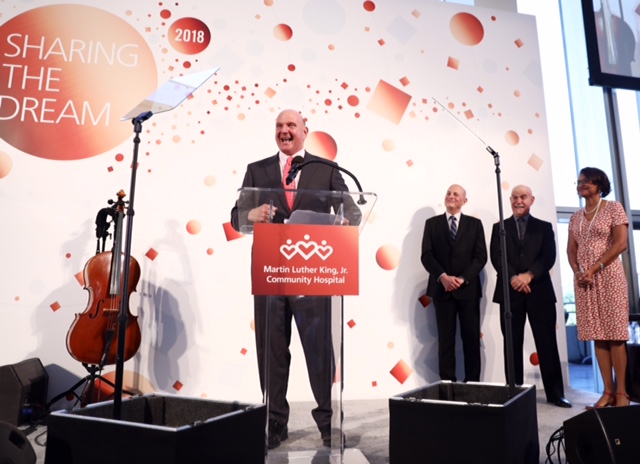Why Aren’t There More Big Health Gifts Like This One?
/Steve Ballmer of the Ballmer Group. photo courtesy of MLKCH
Last week, the Weingart Foundation and the Ballmer Group teamed up to give $15 million so that people in South Los Angeles have more access to doctors. This is one of the poorest parts of a sprawling L.A. metropolis, and few doctors set up shop here, often leaving residents waiting in emergency rooms to get basic care.
While the gift, which went to the Martin Luther King, Jr. Community Hospital (MLKCH), hasn't attracted much attention, it’s actually quite unusual. For all the charitable giving that pours into health causes—around $33 billion in 2016—you’d be surprised how little goes to ensure that low-income communities and people of color have access to basic care. In particular, we don’t see a lot of large gifts from wealthy donors like Steve and Connie Ballmer for this sort of thing.
Many of today’s mega-givers, it seems, have gotten the same memo that hypes high-leverage, high-impact giving. And those who aren’t being coached by the Bridgespans of the world often send their biggest gifts to their alma maters or the top-tier big-city hospitals where they’ve been patients.
What often falls between the cracks are investments in critical under-resourced institutions that serve America’s low-income populations—places like MLKCH or community colleges.
The disparities in giving around health are especially glaring, because we’re literally talking about life and death issues, here. Let me say a bit about this larger picture before swinging back around to the Weingart/Ballmer grant.
The quest to cure dread diseases and alleviate suffering is one of the strongest impulses that guides donors. This has been true since the earliest days of modern philanthropy, when John D. Rockefeller threw big resources into the fight against hookworm, a debilitating disease that then infected some 40 percent of people in the southern United States. Rockefeller also bankrolled the creation of the first biomedical research institute in the U.S., Rockefeller University.
Nearly a century later, when Bill and Melinda Gates turned to large-scale giving, they focused their greatest attention on global health. And these days, as a surge of new wealth flows into philanthropy, it can be hard to keep track of all the big initiatives underway to cure cancer, unlock the secrets of Alzheimer’s or autism, and tackle any number of diseases—from Parkinson’s to diabetes to Lyme disease.
But while this giving is often inspiring, it doesn’t always seem so noble. There’s invariably a personal backstory driving things. In 2014, for example, David Koch explained his $100 million gift to New York-Presbyterian Hospital on Manhattan’s Upper East Side by saying he was a grateful patient and board member. The hedge fund billionaire Jim Simons has poured hundreds of millions into autism research because of a family experience. The Helmsley Charitable Trust has become the largest funder of type-1 diabetes research for a similar reason.
I could go on with many more examples. I could also point to many big gifts to university medical centers by alumni or large donations to top hospitals in cities like New York and Boston that serve the very wealthy.
There’s nothing wrong with this giving. Much of it is pretty cool, actually. In covering many new research initiatives and big hospital gifts at IP, it can be easy to get caught up in the exciting quest for breakthroughs or be sold on the logic of further ramping up a powerhouse like the Mayo Clinic. What’s not to like?
It’s only when you pull the lens back, and ponder the abysmal state of primary care in America, that those shiny new cancer centers and hospital wings start to give you a queasy feeling. Study after study has documented the lack of doctors in inner city and rural America. Recent studies since the Affordable Care Act was enacted have projected that the deficit will only get worse.
What does this shortfall mean in practice? Among other things, it means that preventable health problems aren’t caught earlier and kill people. Heart disease is the No. 1 cause of premature death in America, with mortality rates much higher in rural and poor parts of the U.S. But heart disease can also be prevented and managed, and this is one place where access to a doctor can spell the difference between life and death. Early detection of cancer, the second leading killer in America, is another area where access to physicians can make a big difference.
Yet in South Los Angeles, it’s estimated that another 1,200 doctors are needed to close the gap in care. About half of the patients who go through MLKCH have reported that they have no regular doctor. Mortality rates from chronic diseases like diabetes and heart disease are higher in this area than elsewhere in Los Angeles County.
To address the doctor deficit, the hospital created an affiliated nonprofit Community Medical Group in 2016, which describes itself as “the first viable vehicle in South Los Angeles to attract talented and diverse physicians who want to serve a safety-net community.” Now that medical group, and the hospital behind it, are getting a big shot in the arm from two important funders.
It’s a nice story. I only wish we could report gifts like this in Inside Philanthropy more often.







































